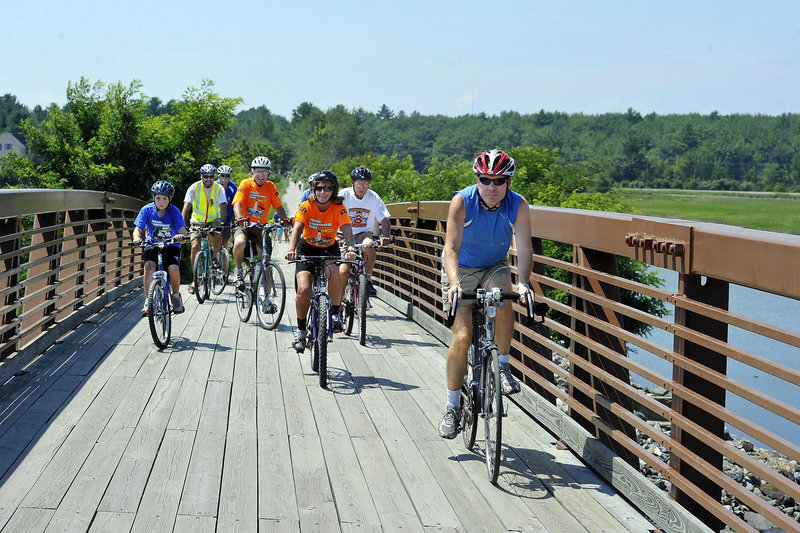Advocates for making Maine friendlier for cyclists and walkers are expressing concerns about federal funding cuts to programs that communities often use to pay for bike lanes, crosswalks and road safety programs aimed at schoolchildren.
But the Maine Department of Transportation is dismissing some of the worst-case scenarios being discussed, saying it’s too early to tell precisely how the federal cuts could affect the state’s bicycle and pedestrian safety programs.
President Obama is expected to sign the first multi-year transportation funding bill since 2009 in a ceremony today, roughly one week after Congress approved the $120 billion spending plan.
The bill maintains overall funding levels for the next 27 months, but cuts funding for bike and pedestrian safety programs by about 30 percent.
The bill also makes money available for additional types of non-highway projects and gives states more discretion in spending, allowing them to divert money intended for bicycle or pedestrian projects to other transportation needs.
The result, says the head of the Bicycle Coalition of Maine, is a potential “triple-whammy” to projects aimed at making Maine more bike- and pedestrian-friendly.
“This bill absolutely impacts Maine and will most likely reduce the number of bicycle-pedestrian projects being completed,” said Nancy Grant, executive director of the Bicycle Coalition of Maine.
But the scope of the potential cuts is up for debate.
America Bikes, a national advocacy group, released an analysis saying that the transportation budget could reduce funding for bicycle and pedestrian projects by 60 percent to 70 percent — about double the actual cut.
For that to happen, however, every state would have to take advantage of the language in the bill allowing states to divert funding to other transportation needs.
Dan Stewart, bicycle and pedestrian program coordinator for the Maine Department of Transportation, dismissed such large figures as “misinformation” and said it is premature to say how state programs will be affected.
“We don’t know if there is even going to be a 30 percent reduction in Maine,” Stewart said. “That’s a national (figure), and the effect on states may vary.”
What is clear is that demand in Maine far outstrips available funding for programs to make the state’s streets more bike- and pedestrian-friendly.
Stewart said his department received $45 million worth of requests from 92 municipalities that sought shares of funding in a recent application period. The budget for bike and pedestrian projects has been about $7 million to $8 million in recent years, he said.
Federal transportation budgets aren’t the only source of funding for those projects, Stewart said.
South Portland, for example, recently submitted an application to the National Endowment for the Arts for projects to design bike racks in some neighborhoods and to convert a building in Mill Creek Park into a combination artist’s studio and bike rental location.
“There is a lot of energy locally for these sorts of things,” said Tex Haeuser, South Portland’s director of planning and development, so even if the federal funding shrinks, supporters of bike and pedestrian projects will pursue money from other sources.
Grant, with the Bicycle Coalition of Maine, said the MDOT has been “very committed” to bike and pedestrian programs in recent years and she hopes that support will continue.
She said coalition members will have to ensure that state legislators understand the health, economic and environmental benefits of such projects.
John Brooking of Westbrook, who commutes to South Portland daily by bike, said he has been monitoring the funding issue.
Brooking, who founded a social group that’s intended to help bike commuters meet and network, said interest in biking to work has clearly increased locally in recent years.
Although access to bike lanes or paths is important for creating a bike-friendly atmosphere, Brooking said, cyclists themselves play a crucial role in their own safety and, by extension, how motorists view them.
That is why Brooking teaches a “Cycling Savvy” program to teach cyclists about “the best and safest ways to ride in places where there is no infrastructure.”
Washington Bureau Chief Kevin Miller can be contacted at 317-6256 or at:
kmiller@mainetoday.com
Twitter: @KevinMillerDC
Send questions/comments to the editors.




Comments are no longer available on this story